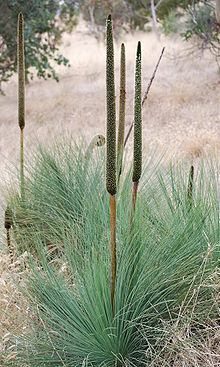Xanthorrhoeoideae
| Xanthorrhoea | |
|---|---|
 |
|
| X. semiplana | |
| Scientific classification | |
| Kingdom: | Plantae |
| Clade: | Angiosperms |
| Clade: | Monocots |
| Order: | Asparagales |
| Family: | Asphodelaceae |
| Subfamily: | Xanthorrhoeoideae |
| Genus: |
Xanthorrhoea Sol. ex Sm. |
| Species | |
| Distribution of Xanthorrhoea | |
| Synonyms | |
|
Acoroides Sol. ex Kite, not validly published |
|
Acoroides Sol. ex Kite, not validly published
Xanthorrhoea (/zænθoʊˈriːə/) is a genus of about 30 species of flowering plants endemic to Australia and a member of family Asphodelaceae, being the only member of subfamily Xanthorrhoeoideae. The Xanthorrhoeoideae are monocots, part of order Asparagales.
A reference to its yellow resin,Xanthorrhoea literally means "yellow flow" in Ancient Greek. Smith named it in 1798, from (‘yellow, golden’) and (‘flowing, flow’). The invalid Acoroides (‘Acorus-like’) was a temporary designation in Solander's manuscript from his voyage with Cook, originally not meant for publication.
Common names for Xanthorrhoea include grasstree, grass gum-tree (for its resin-yielding species), and blackboy, based on the purported similarity in appearance of the trunked species to an Aboriginal man holding an upright spear. The last name is now considered offensive to Aborigines, or at least belonging to the past.
...
Wikipedia
